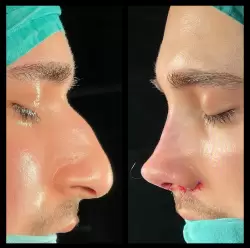What is Nose Aesthetics (Rhinoplasty)?
Rhinoplasty, often called a “nose job”, is a plastic surgery procedure that literally means “changing the nose”. It can be performed to reshape the appearance of the nose and, in some cases, to improve nasal breathing. The procedure can be used to improve both the appearance and function of the nose. Because the nose is a central feature of the face, it is important to choose a surgeon who is experienced in this type of surgery and who has a keen sense of the art of the face – someone who understands the aesthetics of facial proportions.
What are the different types of Nasal Reconstruction?
Aesthetic Rhinoplasty: A procedure that changes the structure and appearance of the nose for purely cosmetic reasons. It can be done to thin the tip of the nose, narrow the nasal bridge, remove a bump on the nasal bridge, or reshape the nose or nostrils.
Cosmetic and Functional Rhinoplasty: When functional rhinoplasty is performed to improve breathing, many patients want cosmetic rhinoplasty to be performed at the same time. It is best to combine cosmetic rhinoplasty with other functional nasal procedures such as septoplasty.
Reconstructive Rhinoplasty: A medically prescribed procedure to repair or restore a nose that has been damaged as a result of an accident, injury or cancer treatment, such as surgical resection of the nose. It may also be recommended to improve breathing in people with deviated septum, a condition in which the cartilage separating the nostrils is misshapen or misaligned, causing partial nasal obstruction.
Revision rhinoplasty: Used as a follow-up procedure after rhinoplasty to further improve or change the results of the initial surgery, it can be performed under local anaesthetic for minor problems. However, if the problem is more serious, the nose may need to be reconstructed, in which case a general anaesthetic is used.
How is Nasal Reconstruction (Rhinoplasty) performed?
There is no standard way of performing rhinoplasty. A qualified surgeon can choose from many different surgical techniques to achieve the desired result. On the other hand, each procedure is designed to meet the patient’s needs and expectations, as well as taking into account the unique structure of the nose. However, the two main surgical approaches to rhinoplasty are as follows:
Closed Rhinoplasty: This is the method in which all incisions are made through the nose and are carefully hidden, leaving no visible scar.
Open Rhinoplasty: A The surgery is performed by making a small incision along the columella (the tissue between the nostrils). The skin covering the nasal bones and cartilage is then lifted, giving the surgeon access to the internal structures of the nose. After the procedure, the skin is put back in place and the incision is closed with stitches.
How long does Rhinoplasty take?
The time required for nose job varies depending on the complexity of the procedure, the surgical approach (open or closed) and the techniques required to achieve an optimal result. In general, however, the operation takes two to three hours. Complex cases and some revision rhinoplasty procedures may take longer time.
Who is an ideal candidate for Nose Job?
Suitable candidates for rhinoplasty are those with a generally healthy body structure. Those with health problems such as diabetes, heart disease or bleeding disorders should make this clear to their doctor before surgery. At the same time, candidates’ nasal bones and cartilage should be fully developed. For this reason, it is not recommended that young people under the age of 18 and adolescents undergo surgery. Identifying suitable candidates for rhinoplasty is extremely important for achieving successful results after surgery. It is therefore important to have an open discussion with the doctor before surgery and to disclose any health problems.
What to expect after Rhinoplasty
After discharge (usually the same day), you will be advised to avoid strenuous activity and exercise for at least two weeks to allow the nose bones to heal and become more stable. Intensive contact sports should be avoided for at least six weeks. Patients should take at least a week off work, even if it is not physically demanding. Other symptoms you may experience include:
Although pain and nausea are usually minimal, you may feel some tenderness or soreness in the first few days after surgery. Your doctor will prescribe painkillers to help you manage any discomfort, although most people think that they do not need them for very long.
You may have a slightly runny or stuffy nose in the first few days. This is normal and to be expected.
Some bruising and swelling can be expected, but this usually disappears within a week to ten days. Ice compresses can be applied for the first few days to keep this to a minimum.
You may have tape or a plastic splint on the outside of your nose. If the curvature of the septum has been repaired, there may also be internal splints. These are usually left in place for a week.
Restoring the normal appearance of the nose after Rinoplasty
The initial swelling will usually go down within a few weeks. However, some swelling may persist for months after the operation and may become more noticeable, usually in the morning. Even when the swelling is gone, the contours of the nose will continue to improve for up to 12 months and the nose will take its final shape after 1 year.
Are the results of Rhinoplasty permanent?
Rhinoplasty permanently changes the structure of your nose, so the results are permanent for life. Normal aging can cause some gradual changes in the appearance of your nose, but most of the improvements seen after nose job are relatively permanent.
Possible complications and risks of Rhinoplasty
Rhinoplasty, like all surgical procedures, carries certain risks and complications. Possible complications and risks of rhinoplasty are as follows
Bleeding: There is a risk of bleeding during or after surgery. Bleeding can usually occur immediately after surgery or within a few days.
Infection: There is a risk of infection following nasal reconstruction. This can be exacerbated if post-operative wound care is not continued properly or if there is a pre-existing infection prior to surgery.
Anaesthetic complications: Rhinoplasty is usually performed under general anaesthetic. Therefore, complications related to anaesthesia may occur. Although rare, serious complications related to anaesthesia can occur.
Asymmetry: Asymmetry or non-symmetrical results in the structure of the nose may occur after surgery. This usually occurs if the correct techniques are not used or if the surgeon is inexperienced.
Deformation of the nose wings: Deformation of the wings of the nose can occur after rhinoplasty. This usually happens if the correct techniques are not used or if the surgeon is inexperienced.
Loss of sensation: Loss of sensation in the nose may occur after rhinoplasty. This is usually temporary and improves within a few weeks.
Wound healing: Wound healing problems can occur after rhinoplasty. This can usually be prevented by careful care in the post-operative period.
In addition to the risks and complications mentioned above, there are other problems that can occur after rhinoplasty. However, it is important to follow the doctor’s instructions correctly and to talk openly with the doctor before the operation to minimise the risks.
Frequently Asked Questions About Rhinoplasty
How Long Does Nose Aesthetic Surgery Take?
The duration of rhinoplasty surgery may vary depending on the scope of the surgery, the procedures to be performed and the patient’s condition. Generally, rhinoplasty operations take between 1-3 hours. However, more complex procedures or revision surgeries may take longer. In addition, factors such as the pre-operative preparation process, application of anesthesia and entering the operating room can affect the total time. Therefore, how long the rhinoplasty surgery will take may be different for each patient.
Which Age Range Is Suitable For Nose Aesthetic Surgery?
The appropriate age range for rhinoplasty surgery is generally 18 years and above, after the adolescence period when the nose development is completed. However, in some exceptional cases, it may be necessary to perform the surgery at an earlier age, for reasons such as a congenital deformity of the nose shape or an accidental deterioration. Rhinoplasty surgery is generally recommended to be performed after the adolescence period, when the nose structure of the person is fully developed. The reason for this is that with the completion of the nose structure, the shape of the nose becomes clear and the surgical result becomes more predictable. However, since each person’s nose structure and needs are different, there is no definite rule about the appropriate age range for surgery. Therefore, it is better to consult with your doctor before the operation.
How Long Does the Nose Shape Take After Nose Aesthetic Surgery?
The shape of the nose after rhinoplasty may change during the healing process. The nose may be full of swelling and bruises for the first few days after surgery. Therefore, it may take several weeks or even several months until the nose shape is fully defined. In the first few weeks, the nose may swell due to edema and bruises, which can cause changes in the shape of the nose. During the healing process, the shape of the nose will gradually become clearer and time will be required for the nasal bones and cartilages to settle in place. It is important to be patient and act in accordance with the healing process until the nose shape is fully formed after rhinoplasty.
















